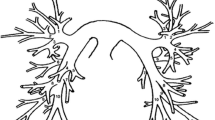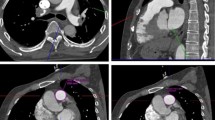Abstract
Acute pulmonary embolism (APE) is a serious disease which is life-threatening. Since it is crucial for APE patients to assess the changes of cardiac function safely and timely, the imaging research of cardiac morphology and function is becoming more and more important. The correlation of computed tomography (CT) measured cardiac parameters and pulmonary obstruction index (POI) was analyzed to discuss the morphological changes of the heart of APE patients in order to provide a new method to evaluate cardiac functions accurately and effectively. 118 APE patients confirmed with CT pulmonary angiography (CTPA) were divided into high-risk group (47 cases, POI ≥ 20) and low-risk group (71 cases, POI < 20) according to the Qanadli Score. The left to right diameter (RL) and the anteroposterior diameter (AP) of the cardiac chambers were compared among the high-risk group, the low-risk group, and the normal group (60 cases). The correlation between CT measured cardiac parameters and the POI was analyzed. Except for left ventricular AP and right atrial AP, there were statistically significant differences (P < 0.05) in the RL and AP of the each cardiac cavity, these parameters meant that right hearts were enlarged and the left hearts were decreased in size. The ratio of right/left heart diameter was statistically significant among the three groups, a < b < c (P < 0.05). Moreover, the POI of 118 APE patients was 14.29 ± 9.53, and there was significant linear correlation between CT measured cardiac parameters and the POI (P < 0.05), excluding the left ventricular AP and right atrial AP. The correlation coefficient reached 0.5 or more in terms of the right atrial LR, the right ventricular LR, the ratio of right/left atrial diameter and the ratio of right/left ventricular diameter. With the increasing value of POI, the right atrium and right ventricular of APE patients were enlarged, and the left atrium and left ventricular were decreased in size. These heart changes can be observed by using CTPA, even non-enhanced chest CT.



Similar content being viewed by others
References
El-Menyar A, Nabir S, Ahmed N et al (2016) Diagnostic implications of computed tomography pulmonary angiography in patients with pulmonary embolism. Ann Thorac Med 11(4):269–276
Dahhan T, Siddiqui I, Tapson VF et al (2016) Clinical and echocardiographic predictors of mortality in acute pulmonary embolism. Cardiovasc Ultrasound 14(1):44
Barrios D, Morillo R, Lobo JL et al (2017) Assessment of right ventricular function in acute pulmonary embolism. Am Heart J 185:123–129
Qanadli SD, El Hajjam M, Viellard-Baron A et al (2001) New CT index to quantify arterial obstruction in pulmonary embolism: comparison with angiographic index and echocardiography. AJR Am J Roentgenol 176(6):1415–1420
Konstantinides SV, Torbicki A, Agnelli G et al (2014) 2014 ESC guidelines on the diagnosis and management of acute pulmonary embolism. Eur Heart J 35:3033–3069
Wärntges S, Konstantinides SV (2015) Progress in the management of acute pulmonary embolism. Curr Opin Pulm Med 21(5):417–424
Konstantinides S, Goldhaber SZ (2012) Pulmonary embolism: risk assessment and management. Eur Heart J 33(24):3014–3022
Agnelli G, Becattini C (2010) Acute pulmonary embolism. N Engl J Med 363:266–274
Pinsky MR (2016) The right ventricle: interaction with the pulmonary circulation. Crit Care 20:266
Cotugno M, Orgaz-Molina J, Rosa-Salazar V et al (2017) Right ventricular dysfunction in acute pulmonary embolism: NT-proBNP vs. troponin T. Med Clin 148(8):339–344
Gonzalez G, Jimenez-Carretero D, Rodriguez-Lopez S et al (2015) Automated axial right ventricle to left ventricle diameter ratio computation in computed tomography pulmonary angiography. PLoS ONE 10:e0127797
Jia D, Zhou XM, Hou G (2017) Estimation of right ventricular dysfunction by computed tomography pulmonary angiography: a valuable adjunct for evaluating the severity of acute pulmonary embolism. J Thromb Thrombolysis 43(2):271–278
Meinel FG, Nance JW Jr, Schoepf UJ et al (2015) Predictive value of computed tomography in acute pulmonary embolism: systematic review and meta-analysis. Am J Med 128(7):747–759
Vedovati MC, Germini F, Agnelli G et al (2013) Prognostic role of embolic burden assessed at computed tomography angiography in patients with acute pulmonary embolism: systematic review and meta-analysis. J Thromb Haemost 11(12):2092–2102
Vamsidhar A, Rajasekhar D, Vanajakshamma V et al (2017) Comparison of PESI, echocardiogram, CTPA, and NT-proBNP as risk stratification tools in patients with acute pulmonary embolism. Indian Heart J 69(1):68–74
Méan M, Tritschler T, Limacher A et al (2017) Association between computed tomography obstruction index and mortality in elderly patients with acute pulmonary embolism: a prospective validation study. PLoS ONE 12(6):e0179224
Meyer G, Sanchez O, Jimenez D (2015) Risk assessment and management of high and intermediate risk pulmonary embolism. Presse Med 44:e401–e408
Praveen-Kumar BS, Rajasekhar D, Vanajakshamma V (2014) Study of clinical, radiological and echocardiographic features and correlation of Qanadli CT index with RV dysfunction and outcomes in pulmonary embolism. Indian Heart J 66(6):629–634
Käberich A, Wärntges S, Konstantinides S (2014) Risk-adapted management of acute pulmonary embolism: recent evidence, new guidelines. Rambam Maimonides Med J 5(4):e0040
Sokalskis V, Peluso D, Jagodzinski A et al (2017) Added clinical value of applying myocardial deformation imaging to assess right ventricular function. Echocardiography 34(6):919–927
Kumamaru KK, George E, Ghosh N et al (2016) Normal ventricular diameter ratio on CT provides adequate assessment for critical right ventricular strain among patients with acute pulmonary embolism. Int J Cardiovasc Imaging 32(7):1153–1161
Yeon SB, Salton CJ, Gona P et al (2015) Impact of age, sex, and indexation method on MR left ventricular reference values in the Framingham Heart Study Offspring Cohort. J Magn Reson Imaging 41:1038–1045
Funding
No funds were used for the present study.
Author information
Authors and Affiliations
Corresponding author
Ethics declarations
Conflict of interest
The authors declare that they have no conflict of interest.
Ethical approval
All procedures performed in studies involving human participants were in accordance with the ethical standards of the institutional and/or national research committee and with the 1964 Helsinki declaration and its later amendments or comparable ethical standards. This article does not contain any studies with animals performed by any of the authors.
Informed consent
Informed consent was obtained from all individual participants included in the study.
Rights and permissions
About this article
Cite this article
Guo, ZJ., Liu, HT., Bai, ZM. et al. A new method of CT for the cardiac measurement: correlation of computed tomography measured cardiac parameters and pulmonary obstruction index to assess cardiac morphological changes in acute pulmonary embolism patients. J Thromb Thrombolysis 45, 410–416 (2018). https://doi.org/10.1007/s11239-018-1628-z
Published:
Issue Date:
DOI: https://doi.org/10.1007/s11239-018-1628-z




